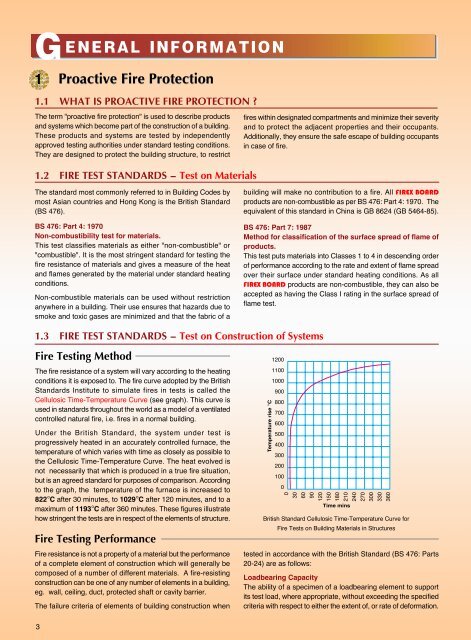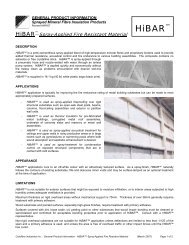FIREX BOARD - Manitoba Green Building Products Directory
FIREX BOARD - Manitoba Green Building Products Directory
FIREX BOARD - Manitoba Green Building Products Directory
You also want an ePaper? Increase the reach of your titles
YUMPU automatically turns print PDFs into web optimized ePapers that Google loves.
G<br />
1<br />
The term "proactive fire protection" is used to describe products<br />
and systems which become part of the construction of a building.<br />
These products and systems are tested by independently<br />
approved testing authorities under standard testing conditions.<br />
They are designed to protect the building structure, to restrict<br />
1.2 FIRE TEST STANDARDS - Test on Materials<br />
The standard most commonly referred to in <strong>Building</strong> Codes by<br />
most Asian countries and Hong Kong is the British Standard<br />
(BS 476).<br />
BS 476: Part 4: 1970<br />
Non-combustibility test for materials.<br />
This test classifies materials as either "non-combustible" or<br />
"combustible". It is the most stringent standard for testing the<br />
fire resistance of materials and gives a measure of the heat<br />
and flames generated by the material under standard heating<br />
conditions.<br />
Non-combustible materials can be used without restriction<br />
anywhere in a building. Their use ensures that hazards due to<br />
smoke and toxic gases are minimized and that the fabric of a<br />
1.3 FIRE TEST STANDARDS - Test on Construction of Systems<br />
Fire Testing Method<br />
The fire resistance of a system will vary according to the heating<br />
conditions it is exposed to. The fire curve adopted by the British<br />
Standards Institute to simulate fires in tests is called the<br />
Cellulosic Time-Temperature Curve (see graph). This curve is<br />
used in standards throughout the world as a model of a ventilated<br />
controlled natural fire, i.e. fires in a normal building.<br />
Under the British Standard, the system under test is<br />
progressively heated in an accurately controlled furnace, the<br />
temperature of which varies with time as closely as possible to<br />
the Cellulosic Time-Temperature Curve. The heat evolved is<br />
not necessarily that which is produced in a true fire situation,<br />
but is an agreed standard for purposes of comparison. According<br />
to the graph, the temperature of the furnace is increased to<br />
822°C after 30 minutes, to 1029°C after 120 minutes, and to a<br />
maximum of 1193°C after 360 minutes. These figures illustrate<br />
3<br />
ENERAL INFORMATION<br />
Proactive Fire Protection<br />
1.1 WHAT IS PROACTIVE FIRE PROTECTION ?<br />
fires within designated compartments and minimize their severity<br />
and to protect the adjacent properties and their occupants.<br />
Additionally, they ensure the safe escape of building occupants<br />
in case of fire.<br />
how stringent the tests are in respect of the elements of structure. British Standard Cellulosic Time-Temperature Curve for<br />
Fire Testing Performance<br />
Fire resistance is not a property of a material but the performance<br />
of a complete element of construction which will generally be<br />
composed of a number of different materials. A fire-resisting<br />
construction can be one of any number of elements in a building,<br />
eg. wall, ceiling, duct, protected shaft or cavity barrier.<br />
The failure criteria of elements of building construction when<br />
building will make no contribution to a fire. All <strong>FIREX</strong> <strong>BOARD</strong><br />
products are non-combustible as per BS 476: Part 4: 1970. The<br />
equivalent of this standard in China is GB 8624 (GB 5464-85).<br />
BS 476: Part 7: 1987<br />
Method for classification of the surface spread of flame of<br />
products.<br />
This test puts materials into Classes 1 to 4 in descending order<br />
of performance according to the rate and extent of flame spread<br />
over their surface under standard heating conditions. As all<br />
<strong>FIREX</strong> <strong>BOARD</strong> products are non-combustible, they can also be<br />
accepted as having the Class I rating in the surface spread of<br />
flame test.<br />
Temperature rise °C<br />
1200<br />
1100<br />
1000<br />
900<br />
800<br />
700<br />
600<br />
500<br />
400<br />
300<br />
200<br />
100<br />
0<br />
0<br />
30<br />
60<br />
90<br />
120<br />
150<br />
180<br />
210<br />
240<br />
270<br />
300<br />
330<br />
360<br />
Time mins<br />
Fire Tests on <strong>Building</strong> Materials in Structures<br />
tested in accordance with the British Standard (BS 476: Parts<br />
20-24) are as follows:<br />
Loadbearing Capacity<br />
The ability of a specimen of a loadbearing element to support<br />
its test load, where appropriate, without exceeding the specified<br />
criteria with respect to either the extent of, or rate of deformation.



